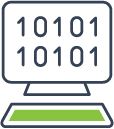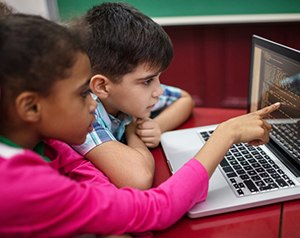EasyCode K-12 Computer Programming Curriculum
Teach students to solve problems using
the language of the future.
Whether or not they grow up to be computer scientists, today’s students need to understand computational thinking, algorithms, app development and how the internet works. Equip students with the critical thinking, computer programming, and design skills to succeed in our digital world.
Develop 21st Century Problem Solvers

Comprehensive K-12 Solution
Develop students’ computer coding, computational thinking and computer science prowess

Student-centered Lessons
Scaffolded coding curriculum features hands-on practice, gamified content and real-world projects

Adapts to Your Classroom
Computer programming lessons allow for asynchronous delivery in traditional, online and hybrid environments
EasyCode™ Computer Programming Curriculum
Available by content area or grade band for elementary, middle school, & high school students
Python
Capstone Projects
Cybersecurity
EasyCode Foundations & Pillars
Classroom to Career Readiness
Introduce the basics of coding through:
![]() Coding Challenges that build familiarity and confidence with computer science.
Coding Challenges that build familiarity and confidence with computer science.
![]() Game Builder Mini-Courses apply basics from coding challenges to develop games in mini-courses.
Game Builder Mini-Courses apply basics from coding challenges to develop games in mini-courses.
![]() Game Builder allows students to create their own games to share with classmates, family and friends.
Game Builder allows students to create their own games to share with classmates, family and friends.
 An ideal extension to EasyCode Foundations, Pillars covers:
An ideal extension to EasyCode Foundations, Pillars covers:
![]() Python Basics: Data types, variables, conditionals, loops, lists, algorithms, debugging, indexes, functions, parameters, returns, boolean and modulo
Python Basics: Data types, variables, conditionals, loops, lists, algorithms, debugging, indexes, functions, parameters, returns, boolean and modulo
![]() Advanced Python: Functional programming, compound conditionals, importing modules, dictionaries, error handling and more
Advanced Python: Functional programming, compound conditionals, importing modules, dictionaries, error handling and more
![]() Capstone Pathways: Graphics, Data and Functions
Capstone Pathways: Graphics, Data and Functions
![]() Certification Pathway: Preparation for Python Coding Apprentice and IT Specialist Certifications
Certification Pathway: Preparation for Python Coding Apprentice and IT Specialist Certifications
![]() Cybersecurity: Cybersecurity lessons cover the concepts of communication systems, hardware, networks, software, the Internet of Things, security, digital citizenship and more
Cybersecurity: Cybersecurity lessons cover the concepts of communication systems, hardware, networks, software, the Internet of Things, security, digital citizenship and more
Introduce the basics of coding through:
- Coding Challenges that build familiarity and confidence with computer science.
- Game Builder Mini-Courses apply basics from coding challenges to develop games in mini-courses.
- Game Builder allows students to create their own games to share with classmates, family and friends.
An ideal extension to EasyCode Foundations, Pillars covers:
- Intro to Python 1: Variables, text, user input, loops, basic conditionals, sequencing and dot notation
- Intro to Python 2: Functions, indexes, events, data types, event handlers, variable scope, program design and game mechanics
- Intro to Python 3: Booleans, nested conditionals, nested loops, lists, dictionaries, error and exception handling, importing modules and writing to files
- Intro to Game Design: Taking turns, moving objects, collisions, random numbers, avoiding hazards and getting points

